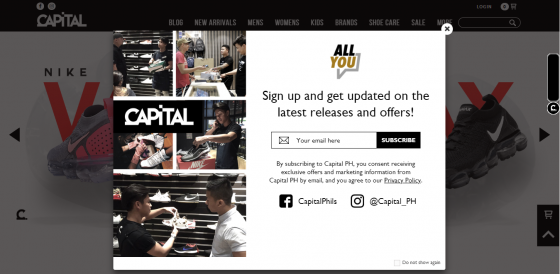Email marketing has gone a long way from its early days. It used to be just like the Wild West, where the policies and regulations against spam weren’t in place yet. You can send unsolicited email to your contact list and not have to worry about getting penalized for it. Nowadays, consumer protection laws such as DPA and CAN-SPAM make it risky for businesses who send spam email.
What is DPA?
The Republic Act of 10173 — more commonly known as the Data Privacy Act of 2012 or DPA — protects the customers’ information that is 1. private (i.e. not publicly available), and / or 2. personally identifiable.

Under the DPA, personal information collected must only be collected for clear and legitimate reasons, which both you (the business) and the individual must consent to, and must not be used for any other purposes. Once collected, your business is responsible for protecting the information you have received from the individual.
Is my business covered by DPA?
The DPA applies to any business or organization that is either “[…] found or established in the Philippines, use equipment that are located in the Philippines, or maintain an office, branch, or agency in the Philippines […]” (National Privacy Commission, 2012). Suffice to say, if your business has had any presence whatsoever in the Philippines, irresponsible handling of personal information can get you imprisoned for 1 – 3 years, and fined at least Php100,000.
How can my marketing campaign comply with DPA?
As with most regulations concerning data protection, opting in is a must. The process must explicitly explain for what purpose you are collecting data. For example, Capital PH makes clear that you are signing up to receive marketing emails from the company, and allows you to review their Privacy Policy:

It also doesn’t ask for more information than necessary.
Subscribers must also be allowed reasonable access to their information, how it is being used, as well as the right to have their information corrected (if inaccurate) or properly removed. For many businesses, this is often included in their Privacy Policy, which should also identify a Privacy Officer within your company. The Privacy Officer will be in charge of the collection, holding, processing, or use of personal information. who controls the collection, holding, processing or use of personal information.
Confused? Just make sure your subscribers know what they’re signing up for, what you’re doing with their information, and how you’re safeguarding it — and you should be good to go!
What is CAN-SPAM?
Controlling the Assault of Non-Solicited Pornography and Marketing Act of 2003 or CAN-SPAM Act protects consumers against unsolicited emails. Its main purpose is to empower subscribers with the choice to opt out of receiving emails from your business.
Is my business covered by the CAN-SPAM Act?
Yes, it is. As long as you use email to reach your customers, you need to ensure you do not violate any of its rules and regulations. Violating CAN-SPAM can be costly with penalties reaching up to $41,484 for each separate email that violates the Act.
How do I make sure my marketing campaign is CAN-SPAM compliant?
It should go without saying that you musn’t send emails to consumers who have not signed up for your mailing list or who have asked not to receive any emails from your business. More importantly, opting out must be easy: the unsubscribe link must be clearly visible and require nothing more than an email address — no other personally identifiable information, and especially no fee. Once consumers choose to unsubscribe from your email marketing list, it is best to implement this automatically.
Whether it’s your brand or the content of your email, don’t misrepresent your business. That is, you can’t claim to be Nike or to be soliciting answers for a survey when in fact you are a fledgling apparel company or are promoting a product, respectively.

State at least once within the email that you are promoting a product or service. Putting something along the lines of “This advertisement was brought to you by [your business name]” at the bottom of your email should get you covered.
Okay, but how do I avoid being marked as spam?
Being DPA and CAN-SPAM compliant is a great first step for email marketers, but that doesn’t make your emails safe from the spam folder. Here are a couple of things you can do to avoid getting your email flagged as spam:
- Use an online spam-checking software such as ISNotSpam. This software helps you check if your email content can get pass spam filters. It also gives you an overview of the causes why your email is being flagged as spam, which can help you address the problem before you carry out your email marketing campaign.
- Churn your subscriber list regularly. Remove subscribers who consistently get a hard bounce as soon as you can. You can make use of spam filtering algorithms to check how many inactive emails are in your list; if this gets past their threshold value, your outgoing emails will be flagged as spam.
- Be vigilant against malware that can utilize your IP address to carry out spamming. For example, most email spamming malware come in the form of package delivery notices or court notices. Once you open it, the malware runs on the background and hijacks your computer with your IP address to send spam. Investing in a good antivirus should be enough to prevent this.
- Keep your open rate high. You can achieve this by perfecting your subject line, properly segmenting your recipient list, and making sure you send your emails at the right time. Provide useful and relevant content to keep your subscribers interested in your newsletter.
- You should also steer clear of certain words that trigger spam filters. These spam words include “amazing”, “cancel at any time”, “free or toll-free”, “great offer”, “risk free”, “this is not spam”, and many others.
You may also want to consider tailoring your email marketing campaign depending on the service/s you offer, and your customers’ needs. Read our article on the different types of marketing emails you can send.




